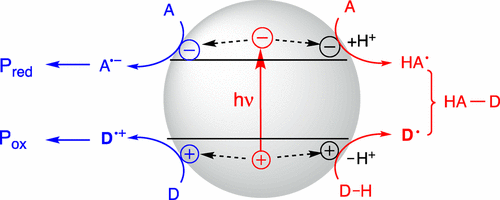当前位置:
X-MOL 学术
›
Acc. Chem. Res.
›
论文详情
Our official English website, www.x-mol.net, welcomes your
feedback! (Note: you will need to create a separate account there.)
Semiconductor Photocatalysis for Chemoselective Radical Coupling Reactions
Accounts of Chemical Research ( IF 16.4 ) Pub Date : 2017-04-05 00:00:00 , DOI: 10.1021/acs.accounts.7b00023 Horst Kisch 1
Accounts of Chemical Research ( IF 16.4 ) Pub Date : 2017-04-05 00:00:00 , DOI: 10.1021/acs.accounts.7b00023 Horst Kisch 1
Affiliation

|
Photocatalysis at semiconductor surfaces is a growing field of general photocatalysis because of its importance for the chemical utilization of solar energy. By analogy with photoelectrochemistry the basic mechanism of semiconductor photocatalysis can be broken down into three steps: photogenerated formation of surface redox centers (electron–hole pairs), interfacial electron transfer from and to substrates (often coupled with proton-transfer), and conversion of primary redox intermediates into the products. Sun driven water cleavage and carbon dioxide fixation are still in the state of basic research whereas aerial degradation reactions of pollutants have reached practical application for the cleaning of air. In addition, a great variety of organic transformations (not syntheses) have been reported. They include cis–trans isomerizations, valence isomerizations, cycloaddition reactions, intramolecular or intermolecular C–N and C–C couplings, partial oxidations, and reductions. In all cases, well-known products were formed but very rarely also isolated. As compared to conventional homogeneous organic synthesis, the photocatalytic reaction mode is of no advantage, although the opposite is quite often claimed in the literature. It is also noted that a high quantum yield does not implicate a high product yield, since it is measured at very low substrate conversion in order to minimize secondary photoreactions. That is especially important in semiconductor photocatalysis since photocorrosion of the photocatalyst often prevents long-time irradiation, as is the case for colloidal metal sulfide semiconductors, which in general are photochemically too unstable to be used in synthesis.
中文翻译:

半导体光催化的化学选择性自由基偶联反应
半导体表面的光催化由于其对太阳能的化学利用的重要性,因此是普通光催化的一个不断发展的领域。与光化学类似,半导体光催化的基本机理可分为三个步骤:表面氧化还原中心(电子-空穴对)的光生形成,从基体到基体的界面电子转移(通常与质子转移结合)以及电子的转化。初级氧化还原中间体进入产品。太阳驱动的水分解和二氧化碳固定仍处于基础研究状态,而污染物的空气降解反应已达到清洁空气的实际应用。此外,各种各样的有机转化(不是合成)) 已经报道。它们包括顺式-反式异构化,化合价异构化,环加成反应,分子内或分子间C–N和C–C偶联,部分氧化和还原。在所有情况下,都形成了众所周知的产物,但很少也将其分离出来。与常规均相有机合成相比尽管在文献中经常提出相反的观点,但是光催化反应模式没有优势。还应注意的是,高量子产率并不意味着高产物产率,因为它是在非常低的底物转化率下测量的,目的是使二次光反应最小化。这在半导体光催化中尤其重要,因为光催化剂的光腐蚀通常会阻止长时间照射,就像胶体金属硫化物半导体的情况一样,胶体金属硫化物半导体通常在光化学上不稳定,无法用于合成。
更新日期:2017-04-05
中文翻译:

半导体光催化的化学选择性自由基偶联反应
半导体表面的光催化由于其对太阳能的化学利用的重要性,因此是普通光催化的一个不断发展的领域。与光化学类似,半导体光催化的基本机理可分为三个步骤:表面氧化还原中心(电子-空穴对)的光生形成,从基体到基体的界面电子转移(通常与质子转移结合)以及电子的转化。初级氧化还原中间体进入产品。太阳驱动的水分解和二氧化碳固定仍处于基础研究状态,而污染物的空气降解反应已达到清洁空气的实际应用。此外,各种各样的有机转化(不是合成)) 已经报道。它们包括顺式-反式异构化,化合价异构化,环加成反应,分子内或分子间C–N和C–C偶联,部分氧化和还原。在所有情况下,都形成了众所周知的产物,但很少也将其分离出来。与常规均相有机合成相比尽管在文献中经常提出相反的观点,但是光催化反应模式没有优势。还应注意的是,高量子产率并不意味着高产物产率,因为它是在非常低的底物转化率下测量的,目的是使二次光反应最小化。这在半导体光催化中尤其重要,因为光催化剂的光腐蚀通常会阻止长时间照射,就像胶体金属硫化物半导体的情况一样,胶体金属硫化物半导体通常在光化学上不稳定,无法用于合成。









































 京公网安备 11010802027423号
京公网安备 11010802027423号